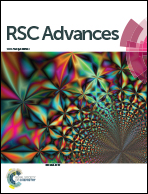Effect of annealing temperature on the structure of carbon encapsulated Fe3O4 nanospheres†
Abstract
Carbon-encapsulated Fe3O4 nanospheres were synthesized by a one-step solvothermal method. The effect of annealing temperature on the structure of carbon-encapsulated Fe3O4 nanospheres was investigated. The morphologies and microstructures of all the products were characterized by field emission scanning electron microscopy, high resolution transmission electron microscopy, X-ray diffraction, N2 adsorption–desorption isotherms, thermogravimetry and vibrating sample magnetometry. The results show that the as-obtained carbon-encapsulated Fe3O4 nanospheres possess a core–shell structure with a size of about 120 nm. The thickness of the carbon layer, specific surface area and pore volume are 20 nm, 33 m2 g−1 and 0.06 cm3 g−1, respectively. With the increase of annealing temperature from 300 to 500 °C for 1 h, the carbon layer of the carbon-encapsulated Fe3O4 nanospheres becomes thinner, and the specific surface area and pore volume become larger. After annealing at 500 °C, the carbon layer thickness, specific surface area and pore volume of the carbon-encapsulated Fe3O4 nanospheres are 13 nm, 191 m2 g−1 and 0.14 cm3 g−1, respectively. After annealing at 600 °C, the carbon-encapsulated Fe3O4 nanospheres change to a yolk–shell structure. When annealed at 700 °C, the carbon layer is destroyed and some Fe nanoparticles are exposed. A plausible formation mechanism for yolk–shell Fe3O4@C nanospheres is proposed.


 Please wait while we load your content...
Please wait while we load your content...